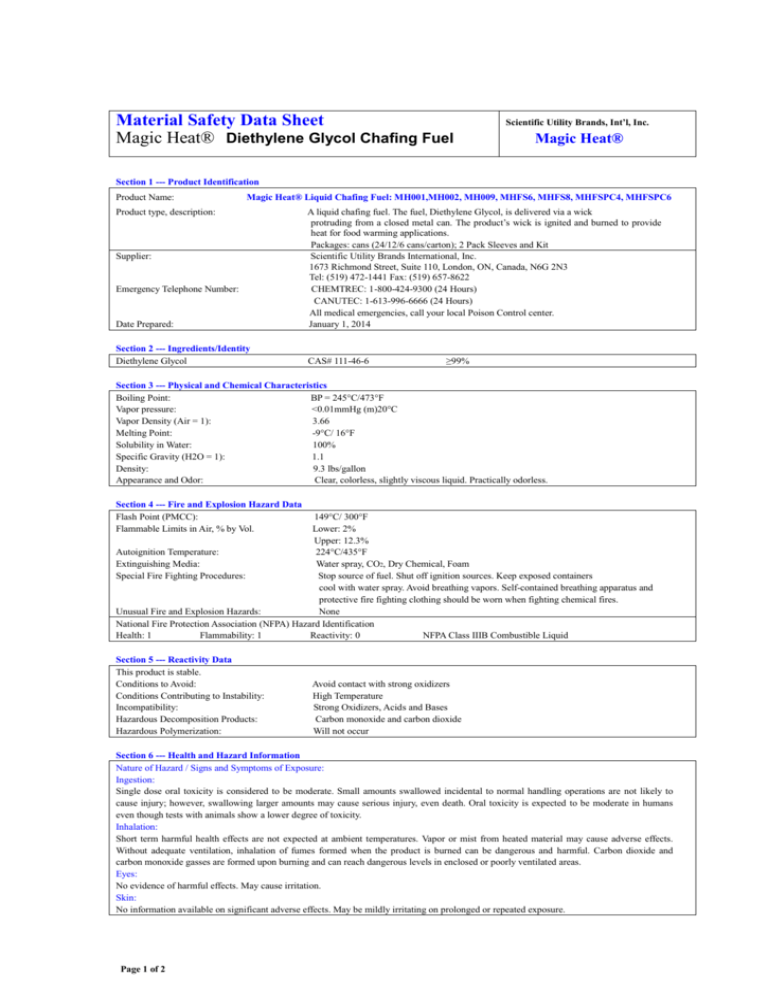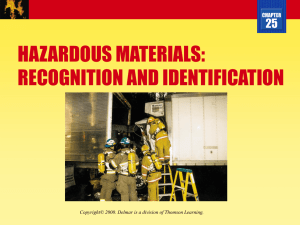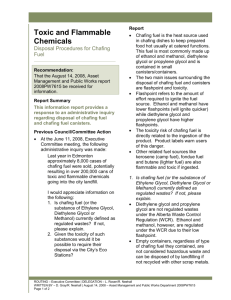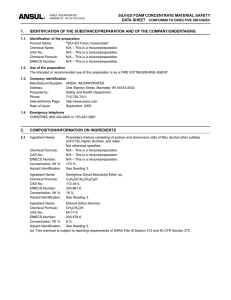MSDS - Del Bac Sales
advertisement

Material Safety Data Sheet Magic Heat® Diethylene Glycol Chafing Fuel Scientific Utility Brands, Int’l, Inc. Magic Heat® Section 1 --- Product Identification Product Name: Magic Heat® Liquid Chafing Fuel: MH001,MH002, MH009, MHFS6, MHFS8, MHFSPC4, MHFSPC6 Product type, description: Date Prepared: A liquid chafing fuel. The fuel, Diethylene Glycol, is delivered via a wick protruding from a closed metal can. The product’s wick is ignited and burned to provide heat for food warming applications. Packages: cans (24/12/6 cans/carton); 2 Pack Sleeves and Kit Scientific Utility Brands International, Inc. 1673 Richmond Street, Suite 110, London, ON, Canada, N6G 2N3 Tel: (519) 472-1441 Fax: (519) 657-8622 CHEMTREC: 1-800-424-9300 (24 Hours) CANUTEC: 1-613-996-6666 (24 Hours) All medical emergencies, call your local Poison Control center. January 1, 2014 Section 2 --- Ingredients/Identity Diethylene Glycol CAS# 111-46-6 Supplier: Emergency Telephone Number: ≥99% Section 3 --- Physical and Chemical Characteristics Boiling Point: BP = 245°C/473°F Vapor pressure: <0.01mmHg (m)20°C Vapor Density (Air = 1): 3.66 Melting Point: -9°C/ 16°F Solubility in Water: 100% Specific Gravity (H2O = 1): 1.1 Density: 9.3 lbs/gallon Appearance and Odor: Clear, colorless, slightly viscous liquid. Practically odorless. Section 4 --- Fire and Explosion Hazard Data Flash Point (PMCC): Flammable Limits in Air, % by Vol. 149°C/ 300°F Lower: 2% Upper: 12.3% Autoignition Temperature: 224°C/435°F Extinguishing Media: Water spray, CO2, Dry Chemical, Foam Special Fire Fighting Procedures: Stop source of fuel. Shut off ignition sources. Keep exposed containers cool with water spray. Avoid breathing vapors. Self-contained breathing apparatus and protective fire fighting clothing should be worn when fighting chemical fires. Unusual Fire and Explosion Hazards: None National Fire Protection Association (NFPA) Hazard Identification Health: 1 Flammability: 1 Reactivity: 0 NFPA Class IIIB Combustible Liquid Section 5 --- Reactivity Data This product is stable. Conditions to Avoid: Conditions Contributing to Instability: Incompatibility: Hazardous Decomposition Products: Hazardous Polymerization: Avoid contact with strong oxidizers High Temperature Strong Oxidizers, Acids and Bases Carbon monoxide and carbon dioxide Will not occur Section 6 --- Health and Hazard Information Nature of Hazard / Signs and Symptoms of Exposure: Ingestion: Single dose oral toxicity is considered to be moderate. Small amounts swallowed incidental to normal handling operations are not likely to cause injury; however, swallowing larger amounts may cause serious injury, even death. Oral toxicity is expected to be moderate in humans even though tests with animals show a lower degree of toxicity. Inhalation: Short term harmful health effects are not expected at ambient temperatures. Vapor or mist from heated material may cause adverse effects. Without adequate ventilation, inhalation of fumes formed when the product is burned can be dangerous and harmful. Carbon dioxide and carbon monoxide gasses are formed upon burning and can reach dangerous levels in enclosed or poorly ventilated areas. Eyes: No evidence of harmful effects. May cause irritation. Skin: No information available on significant adverse effects. May be mildly irritating on prolonged or repeated exposure. Page 1 of 2 Page 2 of 2 Material Safety Data Sheet Magic Heat® Diethylene Glycol Chafing Fuel Signs and Symptoms: Repeated excessive exposures may cause severe kidney damage, and also liver and gastrointestinal effects. Signs and symptoms of excessive exposure may be central nervous system effects, headache, nausea, vomiting, anesthetic or narcotic effects. First Aid / Routes of Entry: Ingestion: If swallowed, give one or two glasses of water. Induce vomiting only as directed by physician or medical personnel. Never give anything by mouth to an unconscious person. Consult medical personnel. Inhalation: Remove to fresh air if effects occur. Eyes: Flush eyes with water and continue for several minutes. Remove contact lenses, if irritation persists, obtain medical attention. Skin: Remove wet clothes. Wash with soap and water. Medical Conditions Which May Be Aggravated by Exposure: Overexposure is unlikely to aggravate existing medical conditions. Repeated excessive exposure may aggravate pre-existing liver and kidney disease. Exposure limits: Acute oral LD50 (rat) is greater than 13 g/kg of body weight and an acute dermal LD50 (rabbit) is greater than 13 g/kg of body weight. (See “Ingestion” above) Carcinogen Status: None. Based on long-term animal studies, diethylene glycol is not believed to pose a carcinogenic risk to man. Hazardous Materials Identification System (HMIS) Health: 2 Flammability: 1 Reactivity: 0 Section 7 --- Spill or Leak Procedures Steps to be taken if material released or spilled: Eliminate all ignition sources. Small spills can be soaked up with absorbent material, or flushed with water. Water Disposal Method: Spilled material may be picked up with solid sorbent and incinerated according to local, state and federal regulations. Empty containers may be disposed of as conventional waste in accordance with all local, state, and federal regulations. Section 8 --- Special Protection Information and Control Measures Work/Hygiene Practices: Avoid contact with skin and eyes. Under normal conditions of product use, no special protection for eyes/skin is required. Remove contaminated clothing; launder or dry-clean before reuse. Minimize breathing vapor or mist. WARNING: Provide adequate ventilation in area of use. DO NOT use this product in an enclosed or poorly ventilated area (i.e.: tents, pantry or closed sealed area unless the area can be adequately ventilated). Open a door or window to provide adequate ventilation. KEEP OUT OF THE REACH OF CHILDREN Precautionary Labeling: WARNING: HARMFUL IF SWALLOWED. KEEP OUT OF THE REACH OF CHILDREN Contains: Diethylene Glycol. If swallowed: drink one or two glasses of water. Induce vomiting only as directed by physician or medical personnel. Work Practices/Engineering Controls: Recap containers when not in use. Do not store near heat or open flame. Section 9 --- Transportation TDG/DOT Classification: Road & Rail – Not Regulated Ocean – Not Regulated Air – Not Regulated Inland Waterways – Not Regulated Nonhazardous by DOT regulations and no specific DOT regulations apply. Not classified as hazardous under the Code of Federal Regulations (CFR) Title 49, Parts 100-177. This product is not a dangerous good as defined by IATA for Air Transportation. US DOT Hazard Class: Not Hazard Classification US DOT Identification Number: Not Applicable UN Number: Not Applicable IMO Hazard Class and Number: Nonhazardous Other Classifications: WHIMIS (Canada): Not controlled under WHIMIS (Canada) DSCL (EEC): R36/38 – Irritating to eyes and skin The information and recommendations contained herein are to the best of Scientific utility Brands International, Inc’s knowledge and belief, accurate and reliable as of the date issued. Scientific Utility Brands International, Inc. does not warrant or guarantee their accuracy or reliability, and Scientific Utility Brands International shall not be liable for any loss or damage arising out of the use thereof. The information and recommendations are offered for the user’s consideration and examination, and it is the user’s responsibility to satisfy itself that they are suitable and complete for their particular use. The Hazardous Materials Identification System (HMIS) and National Fire Protection Association (NFPA) ratings have been included by Scientific Utility Brands International, Inc. in order provide additional health and hazard classification information. The ratings recommended are based upon the criteria supplied by the developers of these ratings systems, together with Scientific Utility Brands International, Inc. interpretation of the available data. Scientific Utility Brands International, Inc.








